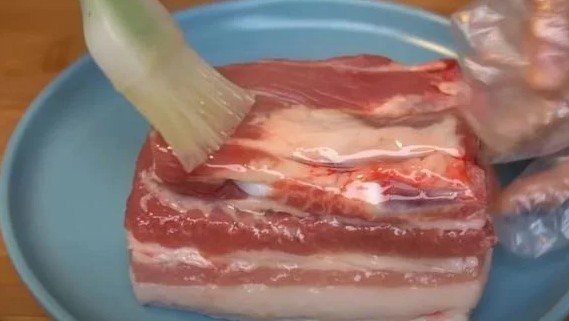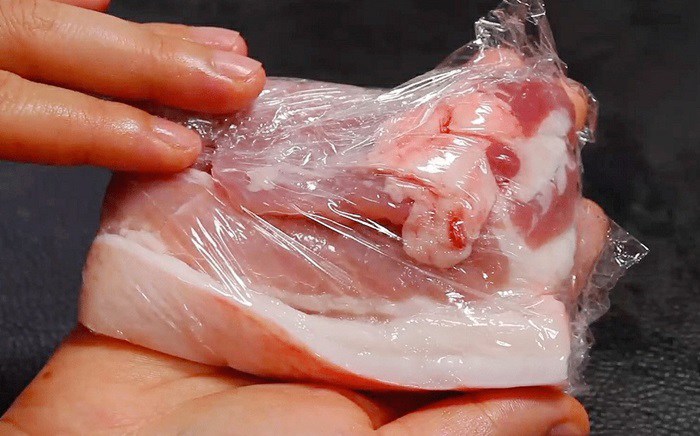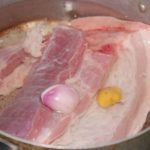Preparation:
– 1kg of pork, 2 cups of white wine, a little cooking oil, and plastic food wrap.
Note: If you need to preserve a larger amount of meat, adjust the quantities of the other ingredients accordingly, maintaining the same ratio.
Instructions:
First, use paper towels to pat dry any excess blood from the pork. It is important not to rinse the meat with water, as this can damage the fat layer on the surface, reducing the preservation time.
Once dried, divide the pork into equal portions according to your usual meal sizes. You can cut it into 3-4 pieces, depending on your family’s appetite. Then, take a small bowl and pour in the white wine. Using a brush, coat each piece of pork with a layer of wine, paying attention to the crevices. This step disinfects the meat.

Next, take another small bowl and pour in one-third of the cooking oil. Use a brush to apply a thin layer of oil to the surface of the meat. This oil layer helps retain moisture and nutrients in the pork.

Once you’ve completed these steps, it’s time to package the meat. Place each portion into separate clean food bags or wrap them tightly in plastic food wrap, ensuring you remove as much air as possible. This creates a vacuum-like effect, prolonging the meat’s freshness. Then, take some aluminum foil sheets of equal size and wrap each packaged portion again. The foil acts as a barrier against moisture and cold air from the freezer, preventing the pork from becoming overly tough.
Finally, store these packages in the freezer. With this method, your pork will remain fresh for up to six months.
Tip for preserving pork without a refrigerator:
In case of power outages or if you don’t have access to a refrigerator, here are some alternative methods to preserve your pork:
-Using Alcohol:
Alcohol, wine, and enzymes can be effective preservatives for pork. Simply rinse the meat, let it air dry, and then soak it in alcohol. This method not only keeps the meat fresh but also tenderizes it.
-Preservation with Salt:
Salt is commonly used to cure fresh seafood, meat, and more to prevent spoilage. Its high NaCl content inhibits bacterial growth. To preserve pork with salt, follow these steps:
After purchasing your pork, rinse it and cut it into thin slices. Rub salt onto each piece and then place them in a dry, cool place. Before cooking, remember to rinse the meat thoroughly to remove the salt.
-Preservation with Vinegar:
Vinegar is an excellent antioxidant and preservative, known for its ability to maintain food color and freshness while also removing odors. To use vinegar for pork preservation:
Instead of rinsing the pork with water, use vinegar to clean the meat. Then, take a clean cloth, dip it in vinegar, and wrap the meat. This will protect the pork from spoilage for a short period without refrigeration. Before cooking, rinse the meat thoroughly.
Additionally, vinegar helps tenderize the meat, saving you time during meal preparation.
With this method, you can rest assured that your pork will remain fresh and tasty without the need for refrigeration.
-Preservation with Honey:
Honey is a fantastic natural preservative for pork. Its composition includes various types of sugars, antioxidants, and vitamins, all of which contribute to meat preservation. To use honey for preservation:
After purchasing your pork, rinse and cut it into small pieces. Apply a thin layer of pure honey to the surface of each piece. Then, hang the meat in a clean, airy space.
Not only will this method extend the shelf life of the pork, but the honey’s natural sweetness will also enhance the flavor of your dishes.
Source: Nguoi Dua Tin






































